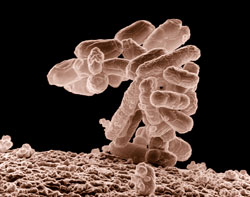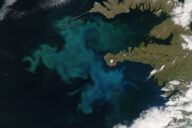Utah monitors waterways for E. coli
0
E. coli bacteria
The Utah Division of Water Quality has begun its statewide testing of more than 40 recreational bodies of water for E. coli contamination. Officials said E. coli flare-ups are typical in warmer weather. Both the water and the beaches will be checked for contamination, but only a select number of waterways and beaches will be evaluated.
“We don’t have the resources to test all bodies of water, so we focus on areas that have a high concentration of swimmers,” Leah Ann Lamb, Division of Water Quality assistant director, told the Associated Press. Lamb also said the department would inform people about the safety status of the water. If it’s unsafe, posted signs will prohibit swimming.
An E. coli Workgroup was formulated about a year ago to focus on the E. coli monitoring.
“We created an E. coli Workgroup to expand cooperative monitoring of recreational waters throughout the state,” said Walt Baker, Utah Division of Water Quality director, in a press release last year.
In June 2010, Utah’s Salem Pond had staggering levels of E. coli. Advisories were posted around the area admonishing visitors against swimming or wading in the water, according to the Daily Herald. Despite Lamb’s recent comments that there was a positive correlation between the amount of time the E. coli is present in the water and determining its source, researchers were unable to conclude the contamination source for Salem Pond.
Julia Hall, Utah department of Health epidemiologist, stressed the importance of educating the public about using natural bodies of water.
“The public needs to understand that natural bodies are not like swimming pools which have chlorine, ponds and lakes have bacteria and it’s important for people to realize that they can be susceptible to diseases if they swallow water in these areas,” Hall told the Associated Press.
The E. coli Workgroup’s website states the team comprises members of state, federal, and local agencies, but it encourages all interested persons to attend their quarterly sessions. The workgroup aims to inform the public about E. coli contamination, observe and implement in other states, establish a format for issuing warnings, and collaborate with the Utah Monitoring Council.
Researchers and trained professionals will test both water and beaches for E. coli monthly until September 5, 2011.
Utah to test lakes, ponds for E. coli [Associated Press] Agencies team up to monitor popular waters for E. coli [State of Utah Department of Environmental Quality] E. coli levels high at Salem Pond [Daily Herald] FAQ’s about E. coli in Utah’s lakes and reservoirs [State of Utah Department of Environmental Quality] E. coli Workgroup [Utah Division of Water Quality]
Image Credit: http://en.wikipedia.org/wiki/File:E_coli_at_10000x,_original.jpg













